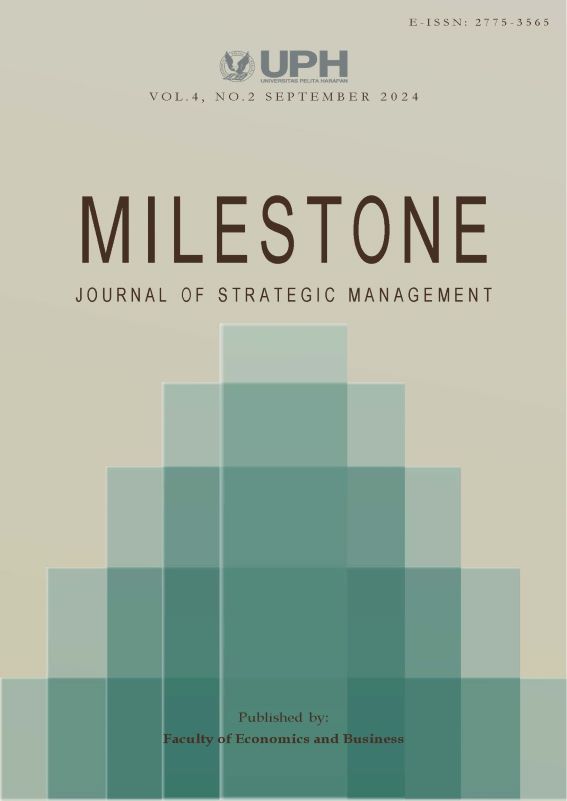PREDICTION OF HEALTH INSURANCE PRODUCT PURCHASE ALLOCATION IN VARIOUS INDUSTRIES IN INDONESIA USING THE RANDOM FOREST METHOD
DOI:
https://doi.org/10.19166/ms.v4i2.8752Λέξεις-κλειδιά:
Premium Prediction, CRIPS-DM, Random ForestΠερίληψη
The objective of this research is identifying which industry can absorb the product of wealth management such as health insurance. Secondly is to identify what the most factors important to determine closing the health insurance premium. The life insurance penetration and density in Indonesia is the lowest level among the Asian country, so the data population in this research is from 38 different companies from different types of industries with 143 data sample, by using the purposive sampling. Most factors which influence the purchasing of health insurance are Listrik, Industry, domicile, age and position, whether the industry that the most contribution for the health insurance sales is banking and education industry. The methodology that is used in this research is called CRIPS-DM (Cross Industrial Standards Program Data Mining). The first steps what is the purpose of the organization, and the second is what data that needed, and continue to data preparation, after modeling, it will make an interpretation of the result, and the final steps is deployment, it will plan how it will be implemented in the real world, and the accuracy score from this model is 58%. From the result of the projection closing health insurance from each industry, it can be concluded that the most industry that closed the health insurance is Banking Industry, the second is from insurance and the third is education and the next is education, retail, health, manufacturing and finance, hospitality, legal, publishing, technology and government and service industries.
Αναφορές
Duarte, V., Zuñiga-Jara, S., & Contreras, S. (2022). Machine learning and marketing: A systematic literature review. IEEE Access, 10, 93273-93288. https://doi.org/10.1109/ACCESS.2022.3202896
Gkikas, D. C., Theodoridis, P. K., & Beligiannis, G. N. (2022). Enhanced marketing decision making for consumer behaviour classification using binary decision trees and a genetic algorithm wrapper. Informatics, 9(2), 1-29. https://doi.org/10.3390/informatics9020045
Jijo, B. T., & Abdulazeez, A. M. (2021). Classification based on decision tree algorithm for machine learning. Journal of Applied Science and Technology Trends, 2(1), 20-28. https://doi.org/10.38094/jastt20165
Lopus, J. S., Amidjono, D. S., & Grimes, P. W. (2019). Improving financial literacy of the poor and vulnerable in Indonesia: An empirical analysis. International Review of Economics Education, 32(11), 196-202. https://doi.org/10.1016/j.iree.2019.100168
Muhajir, M., & Widiastuti, J. (2022). Random forest method approach to customer classification based on non-performing loan in micro business. Jurnal Online Informatika, 7(2), 177-183. https://doi.org/10.15575/join.v7i2.842
Müller, A. C., & Guido, S. (2017). Introduction to machine learning with python: A guide for data scientists. O'Reilly Media.
Ong, A. K. S., Cordova, L. N. Z., Longanilla, F. A. B., Caprecho, N. L., Javier, R. A. V., Borres, R. D., & German, J. D. (2023). Purchasing intentions analysis of hybrid cars using random forest classifier and deep learning. World Electric Vehicle Journal, 14(8), 1-26. https://doi.org/10.3390/wevj14080227
Otoritas Jasa Keuangan. (2023). Roadmap pengembangan perasuransian Indonesia 2023-2027. Departemen Pengaturan dan Pengembangan IKNB, OJK. www.go.id
Rapidminer, Academy. (2024). Data science professional. Rapidminer Academy. https://academy.rapidminer.com/learning-paths/data-science-professional-with-rapidminer
Singgalen, Y. A. (2024). Implementation of CRISP-DM for social network analysis ( SNA) of tourism and travel vlog content reviews. Jurnal Media Informatika Budidarma, 8(1), 572-583. https://doi.org/10.30865/mib.v8i1.7323
Winston, P. H. (2017). On computing machinery and intelligence. Boston Studies in the Philosophy and History of Science, 324, 265-278. https://doi.org/10.1007/978-3-319-53280-6_11
Λήψεις
Δημοσιευμένα
Τεύχος
Ενότητα
Άδεια
Authors who publish with this journal agree to the following terms:
1) Authors retain copyright and grant the journal right of first publication with the work simultaneously licensed under a Creative Commons Attribution License (CC-BY-SA 4.0) that allows others to share the work with an acknowledgement of the work's authorship and initial publication in this journal.
2) Authors are able to enter into separate, additional contractual arrangements for the non-exclusive distribution of the journal's published version of the work (e.g., post it to an institutional repository or publish it in a book), with an acknowledgement of its initial publication in this journal.
3) Authors are permitted and encouraged to post their work online (e.g., in institutional repositories or on their website). The final published PDF should be used and bibliographic details that credit the publication in this journal should be included.





